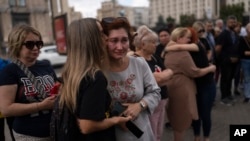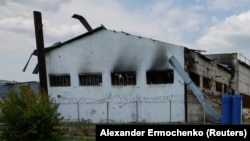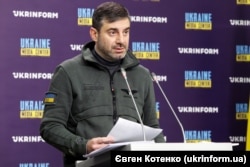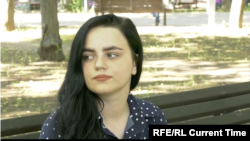For nearly a year, Arina Khavanskikh lived in the hope that her husband, Serhiy, was still alive and could one day return from being taken as a prisoner of war (POW) by Russian forces when his Azov Regiment laid down their arms after holding out in Mariupol’s Azovstal steel plant for three months.
But in June, that hope was finally taken away from her when she received a call from Ukrainian investigators that had been conducting DNA examinations of the bodies of Ukrainian soldiers killed in an explosion in a Russian prison camp exactly one year ago.
“They sent me a photo from the morgue,” Khavanskikh told Current Time, a Russian-language network run by RFE/RL in cooperation with VOA. “I recognized my husband from the photographs.”
Khavanskikh and Serhiy married shortly before Russia’s full-scale invasion in February 2022, which saw him join the defense of Azovstal. In late May 2022, Serhiy and other soldiers at the steel plant received an order to lay down their arms as he and many others from his regiment were taken to a prison camp on the outskirts of Olenivka village -- about 19 kilometers from the eastern Ukrainian city of Donetsk.
Early on July 29, 2022, a mysterious explosion tore through the prison in Olenivka that housed Ukrainian detainees. The blast killed at least 53 people, including Serhiy. All or most of the POWs at the detention complex were members of the Azov Regiment who had surrendered in May 2022 after resisting a lengthy siege that turned them into Ukrainian folk heroes and made them the focus of prisoner-exchange negotiations between Moscow and Kyiv.
Russia promptly claimed that the prison camp was fired on by Ukraine using U.S.-supplied HIMARS (High Mobility Artillery Rocket System) rockets. In Ukraine, the incident was called a mass public execution, with some officials referring to it as a Russian terrorist attack meant to punish Azov Regiment fighters for their past resistance.
Both sides continue to blame each other for the explosion and ensuing massacre -- a potential war crime. An international investigation has been hamstrung by a lack of access to the area, but satellite imagery, firsthand testimony, and open-source analysis have begun to fill in some of the blanks about what transpired.
Now, one year after the blast, as Khavanskikh and others who lost loved ones in the explosion have learned their fates, a push for more answers -- and justice -- is underway.
“There has been almost no information about the surviving prisoners of war after the explosion in Olenivka,” said Olha Andrianova, whose fiance, Serhiy Petrenko, was killed in the July 2022 blast. “It’s important not only to achieve the resumption of an international investigation, but most importantly, not to let those who are still in captivity be forgotten.”
What Happened In Olenivka?
Among the detainees in the Olenivka prison camp ahead of the July 29, 2022 explosion were an estimated 1,500 fighters from Azovstal, the ex-commander of the Ukrainian National Guard’s Azov Regiment, Maksym Zhorin, told the Associated Press in August 2022.
Following the blast, Russian defense officials have claimed that Kyiv caused it by using HIMARS in a strike meant to prevent fighters from giving up information. Russian media promptly shared photos of what they claimed were fragments of U.S.-made HIMARS rockets at the scene.
But the Russian claims were quickly met with skepticism. In early August 2022, the Associated Press, citing U.S. intelligence findings, reported that Russia planned to fabricate evidence to pin the blame for the deaths on Ukraine, including by planting ammunition from a HIMARS.
Open-source analysis of available images by experts also seem to show that the destroyed building at the prison appears inconsistent with a HIMARS-launched attack, pointing to a lack of shrapnel marks and craters and only minimal damage to internal walls in the available visuals of the aftermath.
Ukrainian authorities claim that the deliberate transfer of fighters to a new housing area, which was ultimately the area damaged in the blast, demonstrates that Russian forces had planned an attack. Satellite imagery also appears to show physical changes to the complex prior to the attack and multiple former detainees said that prisoners had been housed in a different area from where the blast occurred.
“According to all the information, we can affirmatively say that it was a pre-planned action,” Ukraine’s human rights ombudsman, Dmytro Lubinets, told Current Time during a recent interview, citing the building of a separate barracks in advance as preparations for the explosions.
Ukrainian officials also claim that graves were dug in the prison complex shortly before the explosion. Imagery captured by Planet Labs satellites shows that land at the southern edge of the compound was altered beginning sometime between July 18 and July 21 last year.
Following the 2022 explosion, the Ukrainian Defense Ministry’s Main Intelligence Directorate (HUR) has said that the blast in Olenivka was organized and carried out by Wagner mercenaries acting on the order of Yevgeny Prigozhin, the group’s head who led a short-lived revolt in Russia in June.
In a statement on July 25, Volker Turk, the United Nations high commissioner for human rights, said that the explosion could not have been caused by shelling from a HIMARS-launched rocket, as Russian authorities claimed.
The UN rights body, which said it has conducted extensive interviews with survivors and analyzed additional information, stated that it has not identified the source of the explosion, but would continue to follow up on the incident.
Is An International Investigation Under Way?
Following the attack one year ago, the UN said it planned to launch a fact-finding mission, but doing so has faced stiff resistance within the body from Russian diplomats.
According to the UN Commission on Human Rights, Moscow has not granted requests to access parts of Ukraine under temporary Russian control and has not given satisfactory safety assurances for a site visit.
In January, the UN disbanded its fact-finding mission into the deaths of Ukrainian POWs in Olenivka. Since then, the relatives of the dead and 75 wounded soldiers announced the creation of a new organization to gather evidence and lobby for a fair international investigation.
“A war crime has no statute of limitations,” Lubinets said. “[An investigation] is not a quick process, it’s complicated.”
What Happens Next?
Ukrainian authorities say they continue to push for a resumption of an international investigation and have been documenting evidence on their own and publishing their findings.
For the families of those killed and wounded in Olenivka, their energy is increasingly turned toward finding justice.
Ulyana Osinnya, whose husband Vitaliy was killed in the July 29, 2022 blast, says she was only able to bury her husband a week ago. The Russian side handed over the bodies to their Ukrainian counterparts months previously, but the identification process has moved slowly due to many bodies being burned and disfigured during the explosion.
Osinnya says the main question on her mind lately is why her husband and others were selected to be placed in a newly made building that was blown up while others at Olenivka were not.
“How were these lists compiled and according to what criteria were they chosen?” she asks.
Kyiv has said that Russian forces singled out Ukrainian members of the Azov Regiment days before the blast and moved them to the newly constructed prison building, but it's unclear why some fighters from the group were chosen and others were not.
Khavanskikh shares Osinnya’s sentiment, saying that she does not “believe in the randomness of these lists.”
“We can’t seem to find any logical connection between each of the fighters, because they are of different ages and ranks,” Khavanskikh said. “These are different companies and divisions; Medics, mortarmen, and scouts; but we are sure that these lists are not accidental.”















